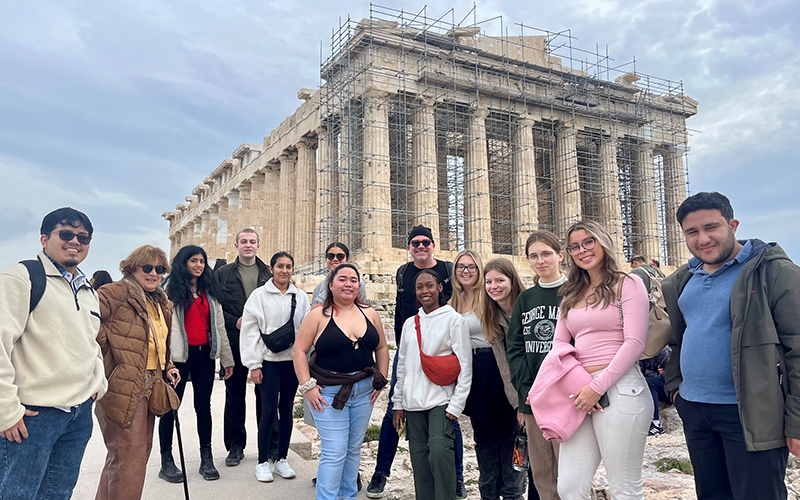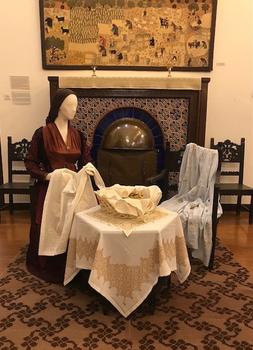

For more than 20 years, an annual winter study-abroad program has offered George Mason University students the opportunity to travel to two of the cities that invented many of our most important political concepts: Athens and Rome. Not only do they study the written and oral foundations of democracy, but they get to experience the aesthetics of power in the art and built structures of these two exciting cities.
The program is true to its title—Monumental Politics—as the program’s focus is on how those European political capitals portray the good—and the bad—of their early efforts to govern.
“It’s a study of political theory, mostly,” said Char R. Miller, an associate professor at Mason’s Schar School of Policy and Government who created the program after first visiting the ancient cities as a political science graduate student in 1999. “The course is the political theory of the monuments. The students read contemporary accounts of aesthetics and affect as well as what authors like Pericles said they were doing in constructing these ancient monuments. This helps them consider the contemporary stakes in understanding how political monuments operate.”
But before getting on a plane the students get on the Metro to see political theory depicted in structures and artifacts in Washington, D.C., not far from the Mason Campus in Fairfax, Virginia.
“We take a field trip and walk around Capitol Hill, the National Mall, the National Gallery of Art, and the American Veterans Disabled for Life Memorial, and talk about aesthetic accounts of politics,” Miller said. “And then we have a class or two here before we go to Athens and talk about how the monuments work.”
Once abroad, the trip provides students with a chance to learn from local experts—thanks to a longstanding partnership with the Museum of Folk Art and Tradition in Athens—which is one of the highlights during a robust two-week itinerary that also includes famous sites, ranging from the Acropolis in Athens to the Forum and Sistine Chapel in Rome.
Miller has taken countless Mason students to the publicly funded Museum of Folk Art and Tradition, founded in 1981 in the bustling Plaka neighborhood of Athens, where museum staff, including museum director Stavroula Pisimisi, generously turns the neoclassical mansion into a temporary classroom amid the singular exhibits of fabrics, embroideries, costumes, and ceramic artwork on exhibit at the museum.
Typical lecture fare includes “The Acropolis of Athens and Its Place in Classical Athens” by Andrew Farrington, a professor of ancient Greek history in the history and ethnology department at Demokritus University, and “Greek National Identity and the Birth of Greek Folklore” by Vassiliki Chryssanthopoulou, an assistant professor of folklore studies at the National and Kapodistrian University of Athens. Over the years, Mason has developed special relationships with both of these universities, including a memo of understanding with Demokritus University.
“I believe that it is a very special activity for the students, as they get to hear not only about ancient Greek monuments, their history, their global significance, and their impact on the shaping of modern Greece, but also about the political and cultural events that have contributed to the formation of contemporary Greek society, culture, and identity and how they relate to Greek monuments and material culture diachronically,” said Chryssanthopoulou by email from Athens.
“The students can link what they hear in the lectures and what they observe during the tour inside the museum to its very building, its exhibits, and the history of the very special person whose home it was, the eminent Greek folklorist, Angeliki Chatzimichali.”
The students also “compare the artifacts they encounter and reflect on their similarities to ones from their own cultural backgrounds and experiences,” she said. “Through their introduction to the life and work of Angeliki Chatzimichali, as it is represented in her own home, the Mason students are given the opportunity to discuss the agency of individuals in shaping the national and civic identities and ideologies of their societies.”
“It was genuinely a life-changing experience,” said Sofie Strompf, an Honors College student majoring in biology. “I think I came out of it a more confident, curious person.”
The study-abroad excursion helped her “fall in love with travel, and I learned the importance of sometimes talking to strangers—I learned a lot about the cultures of people local to Athens and Rome from doing so. Professor Miller encouraged us to expand our comfort zones. The class could have easily been more stressful than fun—three credits in two weeks is a lot—but he structured the class so that we could experience a whole city in a whole other country and do classwork without feeling stressed.”
As for the Angeliki Chatzimichali Museum of Folk Art and Tradition, Strompf was equally wowed.
“The building is gorgeous, and it was amazing to speak to such seasoned professionals in the fields of Greek culture, history, and folklore,” she said. “It was so special to have the opportunity to speak with experts and professors of such specific cultural subjects—while being immersed in the culture they were teaching about.”
Photos of the art and architecture explored by the course are posted on Instagram.
George Mason University and the Schar School strongly encourage study-abroad programs for students at all levels. For more information, see the robust schedule of study-abroad opportunities at Mason’s Global Education Office.
In This Story
Related News
- April 7, 2025
- April 3, 2025
- Schar School’s Michal McElwain Malur Honored with George Mason University Faculty/Staff Alumni AwardApril 2, 2025
- December 16, 2024
- October 11, 2024
